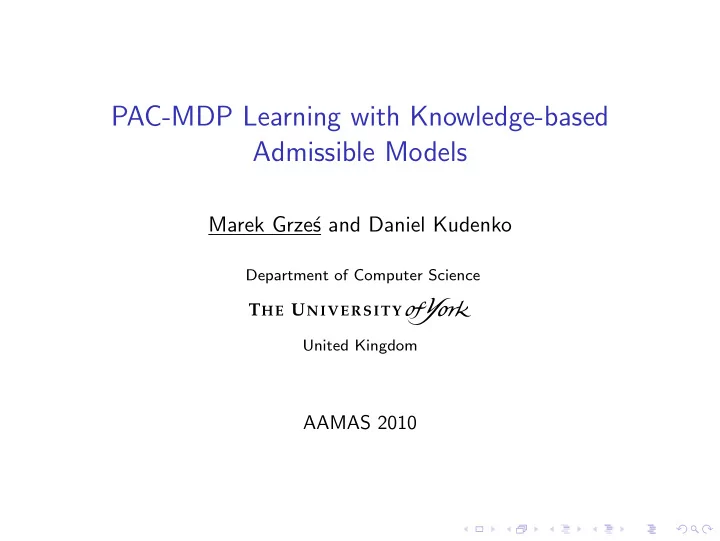

PAC-MDP Learning with Knowledge-based Admissible Models Marek Grze´ s and Daniel Kudenko Department of Computer Science United Kingdom AAMAS 2010
Reinforcement Learning ◮ The loop of interaction: ◮ Agent can see the current state of the environment ◮ Agent chooses an action ◮ State of the environment changes, agent receives reward or punishment ◮ The goal of learning : quickly learn the policy that maximises the long-term expected reward
Exploration-Exploitation Trade-off ◮ We have found a reward of 100. Is it the best reward which can be achieved? ◮ Exploitation : should I stick to the best reward which was found? But, there may still be a high reward undiscovered. ◮ Exploration: should I try more new actions to find a region with a higher reward? But, a lot of negative reward may be collected while exploring unknown actions.
PAC-MDP Learning ◮ While learning the policy, also learn the model of the environment ◮ Assume that all unknown actions lead to a state with a highest possible reward ◮ This approach has been proven to be PAC, i.e., the number of suboptimal decisions is bounded polynomially by relevant parameters
Problem Formulation ◮ PAC-MDP learning vs. heuristic search ◮ Default R-max ‘is like’ best-first search (i.e., A*) with a trivial heuristic h(s)=0 ◮ Heuristic search is efficient when used with good informative heuristics ◮ It is useful and desirable to transfer this idea to reinforcement learning
Problem Formulation ctd ◮ Existing literature shows how admissible heuristics can improve PAC-MDP learning via reward shaping (Asmuth, Littman & Zinkov 2008) ◮ In this work, we are looking for alternative ways of incorporating knowledge (heuristics) into reinforcement learning algorithms ◮ Different knowledge (global admissible heuristics may not be available) ◮ Different ways of using knowledge (more efficient than reward shaping) ◮ We want to guarantee that the algorithm remains PAC-MDP
Determinisation in Symbolic Planning ◮ Action representation: Probabilistic Planning Domain Description Language (PPDDL) ( a p 1 e 1 ... p n e n ) ◮ Determinisation (probabilities known but ignored), e.g., FF-Replan, P-Graphplan ◮ In reinforcement learning probabilities are not known anyway
All-outcomes (AO) Determinisation ◮ Available knowledge: all outcomes e i of each action, a . ( a p 1 e 1 ... p n e n ) ◮ Create a new MDP ˆ M in which there is a deterministic action a d for each possible effect, e i , of a given action a . ◮ The value function of a new MDP, ˆ M , is admissible, i.e., ˆ V ( s ) ≥ V ∗ ( s )
Free Space Assumption (FSA) ◮ Available knowledge: intended (which is either most probable or completely blocked) outcome e i of each action, a . If the intended outcome is blocked, then all remaining outcomes, e i , of a given action are most probable outcomes of different actions. ( a p 1 e 1 ... p n e n ) ◮ Create a new MDP ˆ M in which each action, a , is replaced by its intended outcome. ◮ The value function of a new MDP, ˆ M , is admissible, i.e., ˆ V ( s ) ≥ V ∗ ( s )
PAC-MDP Learning with Admissible Models ◮ Rmax ◮ If (s,a) not known (i.e., n ( s , a ) < m ): use Rmax ◮ if (s,a) known (i.e., n ( s , a ) ≥ m ): use estimated model
PAC-MDP Learning with Admissible Models ◮ Rmax ◮ If (s,a) not known (i.e., n ( s , a ) < m ): use Rmax ◮ if (s,a) known (i.e., n ( s , a ) ≥ m ): use estimated model ◮ Our approach ◮ If (s,a) not known (i.e., n ( s , a ) < m ): use the knowledge-based admissible model ◮ if (s,a) known (i.e., n ( s , a ) ≥ m ): use estimated model
Results 0 -5 Average cumulative reward / 10 3 -10 -15 -20 Rmax-AO RS(Manhattan)-AO RS(Manhattan) RS(Line) Rmax -25 0 0.5 1 1.5 2 2.5 3 3.5 4 Number of episodes / 10 2 Figure: Results on a 25 × 25 maze domain. AO knowledge.
Results 0 -5 Average cumulative reward / 10 3 -10 -15 -20 Rmax-FSA RS(Manhattan)-FSA RS(Manhattan) RS(Line) Rmax -25 0 0.5 1 1.5 2 2.5 3 3.5 4 Number of episodes / 10 2 Figure: Results on a 25 × 25 maze domain. FSA knowledge.
Comparing with the Bayesian Exploration Bonus Algorithm ◮ Bayesian Exploration Bonus (BEB) approximates Bayesian exploration (Kolter & Ng 2009). ◮ (+) It can use action knowledge (AO and FSA) via informative priors. ◮ (-) It is not PAC-MDP. ◮ Our approach shows how to use this knowledge with PAC-MDP algorithms. ◮ Comparing BEB using informative priors with our approach using knowledge-based models (see our paper).
Conclusion ◮ The use of knowledge in RL is important. ◮ It was shown how to use partial knowledge about actions with PAC-MDP algorithms in a theoretically correct way. ◮ Global admissible heuristics required by reward shaping may not be available (e.g., PPDDL domains). ◮ Knowledge-based admissible models turned out to be more efficient than reward shaping with equivalent knowledge: in our case knowledge is used when actions are still ‘unknown’, whereas reward shaping helps only with known actions. ◮ BEB can use AO and FSA knowledge via informative priors. It was shown how to use this knowledge in the PAC-MDP framework (BEB is not PAC-MDP). May 9, 2010
Recommend
More recommend